If One Nitro Is Given but More Than 15 Minutes Goes by Can You Start Over With 3 Again?
- Inquiry
- Open up Access
- Published:
The timing of administering aspirin and nitroglycerin in patients with STEMI ECG changes alter patient outcome
BMC Emergency Medicine volume 21, Article number:137 (2021) Cite this article
Abstruse
Background
Both chewed aspirin and sublingual nitroglycerin are fast interim medications and reach therapeutic levels within a few minutes. Electric current guidelines for managing acute coronary syndrome (ACS) practise not recognize the importance of the society or timing of administering aspirin and nitroglycerin. This retrospective study aimed to examine if there was any benefit to the timing of giving aspirin before or afterward nitroglycerin in cases of ACS.
Methods
From the big National Emergency Medical Services Information System (NEMSIS) 2017 Version database, 2594 patients with astute coronary syndrome were identified (based on chest pain and their ECG finding) that received aspirin plus nitroglycerin in prehospital settings. Based on which medication was given first, the patients were separated in 2 groups: an aspirin-offset and a nitroglycerin-kickoff group. The 2246 patients who received aspirin first were further stratified based on the time betwixt assistants of aspirin and the first dose of nitroglycerin. The other 348 patients who received nitroglycerin first were similarly stratified.
Results
In patients with STEMI ischemia, giving nitroglycerin 10 min after aspirin dosing (compared to giving them simultaneously) leads to a greater than xx% reduction in need for additional nitroglycerin, a greater than 7% decrease in subjective hurting experienced by the patient and reduced need for additional opioids. The aspirin-first group in total, had a 39.6% subtract in subjective hurting experience after giving boosted nitroglycerin compared to nitroglycerin-first grouping.
Conclusion
In patients with ACS, this study establish that giving nitroglycerin 10 min after aspirin was associated with a reduction in subjective pain scores, as well as a reduced need for additional nitroglycerin or opioids. Future prospective trials examining the timing of aspirin vs. nitroglycerin are needed to confirm these findings.
Introduction
Acute coronary syndrome (ACS) is a medical emergency that includes ST-elevation myocardial infarction (STEMI), non-ST top myocardial infarction (NSTEMI), and unstable angina. ACS is a cause of significant morbidity and mortality in the world, and is responsible for 1-3rd of the total deaths in adults over 35 years of historic period worldwide. The first minutes and hours of treating ACS are of the highest importance because the life of the patient and his well-being depend of the actions that are taken initially [1,ii,3].
In the guidelines from American College of Cardiology (ACC) and the American Heart Association (AHA) it is stated that it is wise to give aspirin and nitroglycerin in patients with acute coronary syndrome. Even though the validity of the classical MONA (morphine, oxygen, nitroglycerine and aspirin) therapy in the emergency department (ED) treatment of patients with ACS has begun to be questioned [iv], aspirin plus nitroglycerin is nonetheless given in pre-hospital settings around the earth. The guideline recommends that the patient with acute coronary syndrome should receive aspirin and a maximum of 3 doses of nitroglycerin, five minutes apart. Yet, the current guidelines practise non recognize the importance of the order in which these medications should be given [4, 5].
This study hypothesizes that the order of administering these drugs is important, and giving aspirin several minutes earlier nitroglycerin can pb to a better patient outcome and theoretically can assistance in re-vascularization.
In support of this Gawaz [6] explains that during acute coronary syndrome the atherosclerotic plaque ruptures and thrombus is formed. This thrombus does not e'er lead to complete occlusion of the blood vessel and in some cases the blood circulation breaks the thrombus and leads to micro embolization of more distal arteries. The new techniques of visualization show that these events are relatively common.
Nitroglycerin causes vasodilation of the blood vessels including the artery around the thrombus, and in theory may potentiate the findings described by Gawaz [6]. However, the effect of nitroglycerin is temporary and this claret flow may re-occlude with the propagation of the thrombus. Hypothetically if aspirin is chewed and nowadays in the circulation in a curt period of time before nitroglycerin (5 to 10 min), it will manifest its anti-aggregatory effect on the thrombocytes and this may preclude the propagation of the thrombus and re-apoplexy of the claret vessel. This may theoretically lead to revascularization as explained past Gawaz [six].
The hypothesis is additionally supported by the qualities of both aspirin and sublingual nitroglycerin. This will be additionally elaborated in the give-and-take section.
Materials and methods
This is a retrospective cohort report on archived clinical data. The data were obtained from the NEMSIS dataset (National Emergency Medical Services Data Arrangement) 2017 Version 2018.10032, created on Dec 14, 2018. NEMSIS is a project designed and funded by the US authorities in guild to standardize the reports from events in Emergency Medical Services (EMS) in the Us. The records are nerveless in real time past the medical staff on site, during the medical emergency [7, eight]. All information in this database is checked for double entries, completeness, logical consistency and formatting. Whatsoever data that does not pass this procedure are rejected and non included in the database [9].
Inclusion criteria for the patients were:
- patients that received aspirin plus nitroglycerin.
- patients with ECG findings for anterior, inferior, lateral and posterior STEMI and Not-STEMI ischemia (not all NON-STEMI patients are confirmed by troponin levels, only with ECG changes, chest pain and clinical assessment of the emergency personnel).
- patients with chest pain.
From the large NEMSIS database ix,222,789 unique emergency medical entries were identified. From these entries, particularly written software in Python extracted 347,992 unique patients who received aspirin plus nitroglycerin regardless of the initial diagnosis. With additional filtering for ECG codes and presence of chest pain, we obtained 2594 final cases that had all inclusion criteria (Run into Supplementary 1, nine). Therefore, the final information was a group of patients suggestive for ACS confirmed by ECG findings, chest pain, medications they received and clinical assessment of the emergency personnel.
All information were divided into two main groups. Patients that received aspirin beginning and then nitroglycerin were the aspirin-first group (A-group) and patients that received nitroglycerin first and aspirin 2nd were the nitroglycerin group (Northward-group). A system of codes was assigned for every event inside the groups. A-group with 2246 patients was farther stratified in 9 groups (A1 to A9) based on the fourth dimension betwixt administration of aspirin and the first dose of nitroglycerin (NTG).
The groups created are shown in Table i.
North-grouping with 348 patients, is different in the way that nitroglycerin is given outset and aspirin second. However, in 36 cases it was found that some patients received more than 1 nitroglycerin before aspirin. These additional nitroglycerin doses were manually added as additionally administered nitroglycerin in the N-first group, because the Python software was excluding them. (See Supplementary 6).
This code organization also included the data for the subjective feelings of the patients afterwards receiving each medication, with values of: feeling better (+), feeling same (0) and feeling worse (−). This data of the subjective feeling of the patient was recorded in existent time by medical professionals on site.
All of the above groups were further stratified based on how much boosted nitroglycerin the patients received.
In all groups, if the patient was feeling better later on administration of any medication, the software added the improve (+) sign. For example, A1+ means that the patient received aspirin and within ane min he received nitroglycerin and was feeling better. If the patient received a 2d dose of nitroglycerin and the patient was feeling the same the code was A1 + 20. For a third dose of nitroglycerin if the patient was feeling ameliorate: A1 + 203+ etc. This fashion all groups were additionally stratified in additional 5 groups based on how many additional nitroglycerin dosages were given after the first one (1 Nitro, 2 Nitro, 3 Nitro, 4 nitro, All rest).
A-group and N-group were analyzed and compared between each other. 2 sets of analysis were used.
The beginning set analyzes the administration of boosted doses of nitroglycerin afterwards the first dose. The rationale was that if the patient is objectively feeling better the emergency service (European monetary system) personnel will not give any additional doses of nitroglycerin, therefore reducing the hazard of unnecessary hypotension. The second analysis was on the subjective feelings of the patients. The question was: are patients feeling "improve" (+) or the "same" (0) after receiving the medication. Feeling worse (−) was excluded because of insufficient data. All of the data was analyzed statistically and validated using Chi squared, paired t-test.
Additional testing was done on the vital signs of the patients to confirm the validity of the first 2 sets of assay. Also, additionally we did the aforementioned 2 set of tests on the sectional STEMI group
These two sets of assay were done using Microsoft Excel 16 ver. 16.0.4393.one thousand with NumXL add-on ver. one.63.42402.i and LibreOffice 4.i.6 (Come across Supplementary 2, 3, 7, 8).
Results
We analyzed a full of 2594 patients, divided in ii groups. A-first group contained 2246 patients and N-first group 348 patients, forming a time series of data. Patients were predominantly male person 69.12%; vs 30.87% female person. Average age was 63.72 years. Descriptive information are presented in Table two.
Descriptive data on how unlike groups were formed are presented in Table 3. All figures presented were tested using Chi square of independence and Paired t test.
Giving the 1st dose of nitroglycerin a few minutes after aspirin resulted in a reduction of patients requiring a 3rd dose of nitroglycerin (Fig. 1a). The 1 dose nitroglycerin group has a linear upward trend line progression from A1 to A9 groups, with a slope of ane.35 (Rii 0.66) and the 3 dose nitroglycerine group has downwards slope of −one.26 (R2 0.75). This results in a 23.5% reduction of a tertiary nitroglycerin dose in the A9 group compared to the A1 grouping. Chi square of independence was found to exist pregnant (×2 (16) =forty.21, p = 0.00072). This finding has a linear progression from the A1 to the A9 group.
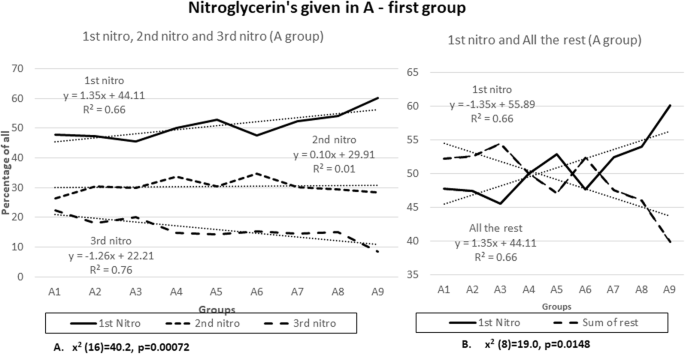
Nitroglycerin's given A-first group
The same correlation was found when the 1 dose nitroglycerine grouping is compared to the sum of all additional nitroglycerin given (Fig. 1b). The analysis showed that there is a 24.3% reduction in dosing of whatsoever additional nitroglycerin after the first ane in the A9 group with pregnant linear progression beyond all groups (Rii 0.66). It is significant that in the A1 group at that place were 11.74% more than patients who received additional nitroglycerin compared to the A9 group where 12.56% of patients received simply 1 dose of nitroglycerin compared to all additional nitroglycerin. These data have significant chi square of independence (× ii (eight) =19.0, p = 0.0148).
This correlation was not found within the N1 group because the data were analyzed and were establish statistically insignificant using chi square of independence.
The second ready of assay analyzed the subjective feeling of the patients after receiving each dose of medication. Similarly, as in the first set of analysis there is a linear trend from A1 to A9 groups. More patients were feeling "better" (+) than "aforementioned" (0) in groups where they received the first dose of nitroglycerin a few minutes after aspirin. Figure 2a shows the sum of i nitro and 2 nitro groups. The better (+) event has an up-sloping progression with a slope of 1.46 (Rtwo of 0.62) and the "same" or (0) issue has a trend line slope of 0.6 (Rii 0.25). This means that the trend lines are diverging and this results in 7.7% more (+) events than (0) in A9 grouping compared to (A1) grouping. Figure 2a was tested with a paired t-examination because it is a set of paired data, derived from 1 and 2 nitroglycerine groups. There was a significant difference in the scores for "better" (+) (M = 160.56, SD = 62,52) and "same" (0) events (M = 111.56, SD = 35,74), conditions: t (eight) =4,45, p = 0.0021.
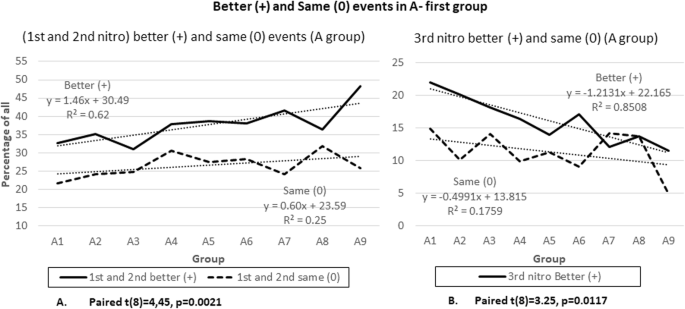
Better (+) and Same (0) events a A-first grouping
Even though both i and 2 nitroglycerine groups independently had a similar linear progression and difference they are presented together for simplicity sake. Same was washed for 3rd and all the residual groups.
The 3rd and the rest of nitroglycerine subgroups had the contrary trend and the trend lines converge (Fig. 2b). This is shown in Fig. 2b where the "amend" or (+) events accept downward slope of − 1.37 (R2 0.66) and the "same" or (0) events accept slope of − 0.72 (R2 0.27). This results in a change of negative 5.85% from A1 to A9, or more patients reported "aforementioned" than "better". Data validity was also tested with paired t test with significant differences in the scores for "improve" (+) (M = 91,67 SD = sixty,eight) and "same" (0) events (K = 64,67, SD = 35.79) conditions: t (8) =two.73, p = 0.0258.
This correlation was non plant within the N1 group because the data were analyzed and were establish insignificant using paired t-test.
Figure iii presents the sum of all "better" (+) and "aforementioned" (0) events for A and N groups. There is a 39.6% deviation betwixt "better" and "same" events between A-group and N-group. Standalone statistical analysis of N-grouping was non possible because the data were not significant. Still, even though statistical analysis of Northward-grouping was non significant it is a large number of patients (348). Because of this, the comparison of the sum of both groups has significance of its ain showing the complete contrary status of these two groups.
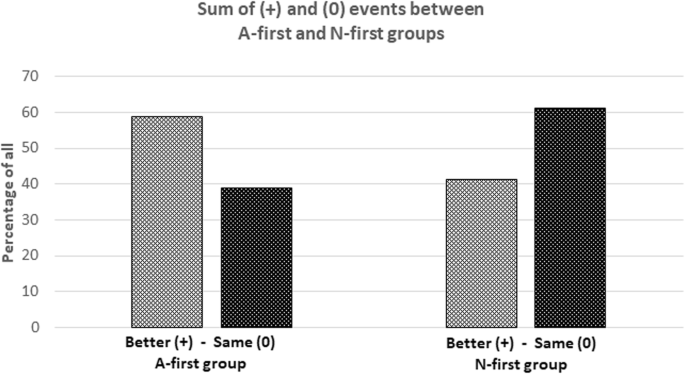
Sum of (+) and (0) outcome between A-first and N-first group
In order to exclude that this trend of reduced nitroglycerin administration in later groups is due to increased use of pain medications we also tested assistants of hurting medications. Nosotros measured simply pain medications given afterwards the showtime nitroglycerin in social club to amend correlate between them. Patients received 3 types of hurting medications:
-
Morphine - 497 given
-
Fentanyl - 302 given
-
Midazolam - 7 given.
Descriptive data of this analysis are presented in Table iv.
Graphic presentation in opioids given is presented in Fig. 4. Information technology is evident that the full number of patients that received opioids has a very weak downward slope of − 0.eighteen (with Rii 0.036) from A1 to A9. However, nosotros designed a coefficient of opioids to include the number of opioids given per group. The need to give opioids is direct proportional to the number of patients that received opioids and the number of opioids that they received and is inversely proportional by the number of patients that are in the group. This can mathematically be presented equally coefficient:
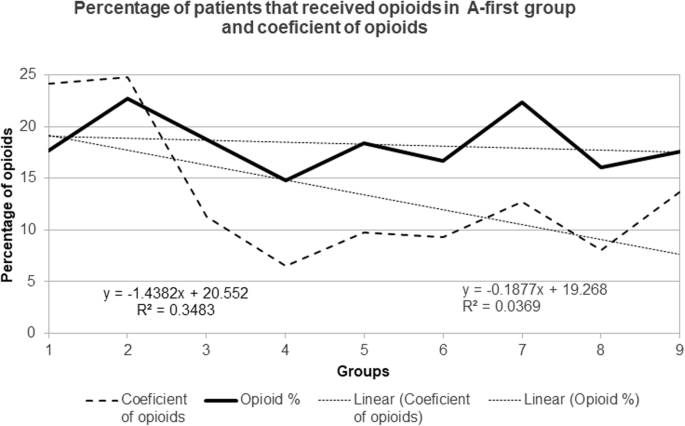
Percentage of patients that received opioids in A-first grouping and coefficient of opioids
Coefficient of opioids = (pts. that received opioids x opioids given) / Total number of patients
This coefficient of opioids regards the number of patients that received opioids and the number of opioids they received. This coefficient has a pregnant downward trend line with slope of 1.44 with a relatively significant Rtwo of 0.34. This shows that in later groups a smaller pct of opioid "load" was needed. However, these information have an insignificant chi square of independence (× ii (16) =eighteen.1, p = 0.316). This means that giving opioids is not dependent on the previous nitroglycerine given or has any relationship between the groups. In other words, giving opioids did non influence the administration of nitroglycerin in the patients. (Encounter supplementary 10).
North-first group had an insignificant number of opioids given and is not presented.
In order to discover some reason why some patients received nitroglycerin shortly subsequently aspirin and some later (A1 through A9), or why some patients received nitroglycerin start nosotros analyzed a number of vital signs and demographic data recorded in the NEMSIS dataset (See Supplementary 4, 5). We tested the averages of:
-
Systolic claret pressure level (SBP),
-
Center charge per unit,
-
Patient acuity at outset and disposition
-
Pulse oximetry findings,
-
Pain severity on a scale from 1 to 10,
-
Type of ischemia (STEMI or NON-STEMI),
-
Historic period,
-
Gender differences.
-
Type of ECG changes
Descriptive data for these analyses are presented in Table 5.
No significant correlation was found for any of the vital signs, except for systolic blood pressure and age of the patients as presented on Figs. v and 6. Patient acuity exam showed improved acuity at disposition for patients marked Carmine and Yellow but data were found statistically insignificant. See supplementary 16 and 17.
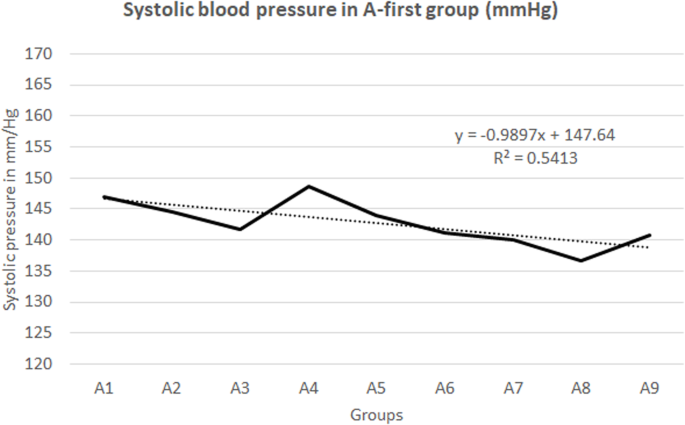
Systolic blood pressure in A-get-go group (mmHg)
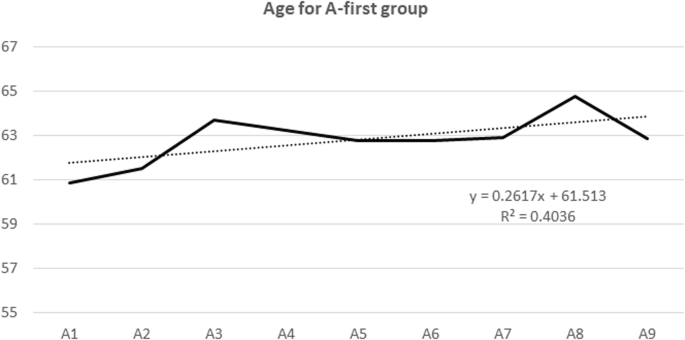
Age for A-get-go group
Effigy v shows a down sloping trend line with gradient of 0.99 (R2 of 0.54) which shows that on average A9 grouping had eight.9 mmHg lower systolic blood pressure level compared to A1 group, and this is a consistent trend from A1 to A9 grouping. To some patients, systolic claret pressure level was measured several times and we only compared the average for the whole group. The rationale backside this decision was to find a pattern that can explain the postponing of nitroglycerin administration.
Nosotros found another significant trend in the A-first grouping regarding the average age. There is an up-sloping tendency (slope 0.26 with Rtwo of 0.4) for the age of the patients from A1 to A9 grouping as presented in Fig. vi. This means older patients received nitroglycerin later in A-group.
No similar correlations and significant trends were found in N-group.
We analyzed which type of ECG changes were most prevalent within the cohort, and the outcome showed that than 92.71% were STEMI myocardial ischemia, and 7.28% were NON_STEMI as shown in Fig. vii. (Encounter Supplementary 12, 13, 14) Due north-start group alone had similar ratio. Out of 348 patients in North-first grouping 323 cases or 92.81% were STEMI and 25 or 7.19% were NON-STEMI patient. (See supplementary fifteen).
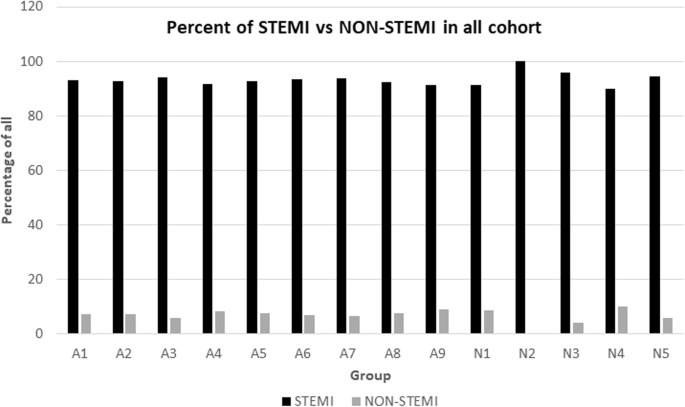
Percent with STEMI vs NON-STEMI in all patients 9 both groups
Finding that more than that 92.71% of all accomplice-patients were with STEMI changes was surprising and we wanted to clarify if in that location are any changes in the findings in this subgroup. The same sets of analyses were conducted on the exclusive 2404 STEMI patients. Again merely A-First group is presented, Northward-Commencement group had insufficient information.
Effigy 8a is very similar to Fig. 1a. The 1 dose nitroglycerin grouping has a linear upward tendency line progression from A1 to A9 groups, with a slope of one.53 (Rtwo 0.63) and the 3 dose nitroglycerine group has downwards slope of − 1.35 (Rii 0.74). This results in a 25.nine% (improvement of 2.four%) reduction of a 3rd nitroglycerin dose in the A9 group compared to the A1 group. Chi square of independence was found to be significant (× 2 (16) = 40.three, p = 0.00070).
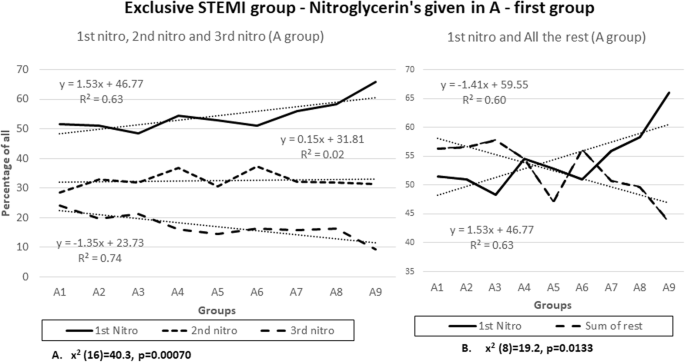
Exclusive STEMI group – Nitroglycerin'southward given in A-first group
The same correlation was constitute when the one dose nitroglycerine group is compared to the sum of all boosted nitroglycerin given (Fig. 8b). The analysis showed that there is a 26.46% (improvement of 2.16%) reduction in dosing of any boosted nitroglycerin afterwards the offset i in the A9 grouping with significant linear progression beyond all groups (R2 0.63 and 0.60). These data accept significant chi square of independence (× 2 (8) = nineteen.2, p = 0.0133).
The second set up of assay shown in Fig. 9 is too very similar to Fig. 2. The improve (+) event has an up-sloping progression with a slope of 1.64 (R2 of 0.62) and the "same" or (0) event has a tendency line slope of 0.vii (R2 0.28). This means that the trend lines are diverging and this results in 8.46% (comeback of 0.76%) more (+) events than (0) in A9 grouping compared to A1 group. The paired t-examination showed a significant difference in the scores for "improve" (+) (M = 146.56, SD = 55,96) and "same" (0) events (Grand = 104.00, SD = 33,49), conditions: t (eight) = four,23, p = 0.0029.
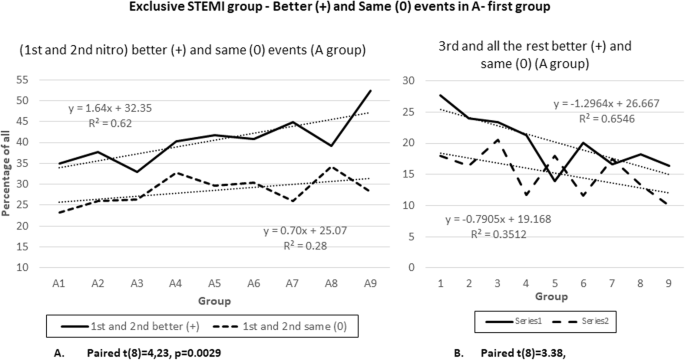
Sectional STEMI grouping – Improve (+) and Same (0) events in a A-first group
The third and all remaining nitroglycerine subgroups again had the opposite trend and the tendency lines converge (Fig. 2b). This is shown in Fig. 2b where the "better" or (+) events have downward gradient of − 1.29 (R2 0.65) and the "same" or (0) events have slope of − 0.79 (R2 0.35). This results in a change of negative 4.55% (reduced past 1.3%) from A1 to A9, or more than patients reported "same" than "better". Data validity was besides tested with paired t test with meaning differences in the scores for "better" (+) (M = 86,67 SD = 56,99) and "same" (0) events (M = 62,22, SD = 35.34) conditions: t (8) = 2.83, p = 0.0221.
Both test in the exclusive STEMI grouping of 2404 patients showed minor improvements over the overall 2594 patients included in the report. The improvements are presented in Tabular array half-dozen.
Word
The results bear witness that during astute coronary syndrome (generally STEMI) it is benign to give aspirin start and give nitroglycerin several minutes later. Tendency lines in Figs. 1 and ii testify that this "intervention" is associated with more than 20% reduced demand for a tertiary nitroglycerin dose and a more 20% reduced need of any additional nitroglycerin if the first nitroglycerin is given x min after aspirin (10 min is selected as a cut-off from the trend line as a round number). This intervention is additionally associated with reduced demand for opioids. In add-on, with this "intervention" patients are feeling more vii% improve later on administering the start or the 2d nitroglycerin when nitroglycerin was given x min afterwards aspirin. In general, patients in A-group were feeling 39.half dozen% better compared to N-grouping (Fig. iii).
Additionally, exclusive STEMI group (2404 patients or 92.71%) produced almost exact trends. Table vi shows that there were modest improvements in all aspects compared to the whole group of 2954 patients. This is important because ECG with STEMI changes is considered a definite sign of acute coronary syndrome, and the intervention is apparently slightly more than effective in this group.
The results are linear and time-dependent (giving nitroglycerin later has a larger do good), nevertheless, the exact timing when nitroglycerin should be given cannot be answered by this study.
Giving opioids has a downwardly sloping tendency line from A1 to A9 groups, just this data was establish to be statistically insignificant (Fig. 4), The coefficient of opioids has a significant downward-sloping trend and may indicate reduced opioids assistants. The conclusion, however, is that in afterward groups nitroglycerin was non replaced with increased opioid use. The most logical reply why these patients received less nitroglycerin is that they did not had any need to receive any additional nitroglycerin because they were feeling better.
Reduced initial systolic blood pressure may be the reason why some patients received their offset dose of nitroglycerin later on compared to others (Fig. 5). Nitroglycerin can cause a dramatic driblet in systolic blood force per unit area and some medical professionals may have been hesitant in administering the nitroglycerin sooner. This may be the reason why medical personnel mostly give nitroglycerin in patients with STEMI ischemia. Majority, or 92.71% of the patients in the dataset, who had received nitroglycerin had STEMI ischemia (Fig. 7).
The historic period of the patient may as well accept played a role in deciding to requite the nitroglycerin later in some patients considering the medical personnel may accept been more cautious with patients who were older and had lower systolic blood pressures (Fig. 6).
The data show that giving nitroglycerin before aspirin may lead to worse subjective feeling of the patient as presented in Fig. iii.
Equally mentioned, Gawaz [vi] shows that during astute coronary syndrome the thrombus does not always pb to consummate occlusion of the claret vessel, and in some cases the blood circulation breaks the thrombus in essence, an event of revascularization. Giving aspirin several minutes before nitroglycerin may potentiate this process, and this may be the reason why patients who received their first nitroglycerin after aspirin were feeling better.
The reason for this may be found in the qualities and nature of these two drugs.
Sean et al. [10] found that chewed aspirin reaches maximum claret concentration later on 27 min. Marking and Byron [11] however, in a randomized and experimental study prove that five min after chewing aspirin the level of thromboxane B2 (TxB2) in the serum decreased 50% from the normal level. They merits this concentration of aspirin is enough for gaining the anti-aggregation issue of the aspirin.
Aspirin affects the thrombus in a qualitative and quantitative way. Normally the thrombus has a compact structure with modest pores and thin fibrin fibers and it is associated with more severe forms of coronary artery illness [12, 13]. Aspirin affects the structure during the formation of the thrombus making it softer and more than easier to deliquesce [14, xv]. Aspirin also affects the structure of already formed thrombus, forming thicker fibrin fibers with bigger pores which causes reduced stability of the thrombus and a greater ability to dissolve [xiv]. In in-vitro conditions aspirin reduces the speed of formation of the thrombus, acts on its structure and size, i.e. creates smaller thrombus [11, 16].
Nitroglycerin is given in astute coronary syndrome for its vasodilatory event. Munemasa et al. [17] showed significant increases in the diameter of the coronary claret vessels earlier and after the application of nitroglycerin with variation ranged from 7.54 to 22.26%, whereas smaller claret vessels showed vasodilatory upshot of xvi.91% compared to the bigger blood vessels which showed xi.35%. Tadamura et al. [18] showed that this vasodilatory effect is most evident exactly at the area where the feasible tissue with ischemia is, i.due east. where information technology is needed the most.
Considering of these "qualities" of aspirin and nitroglycerin, if aspirin is chewed and present in the circulation a short period of time before nitroglycerin (five to 10 min), it may manifest its anti-aggregatory effect. When nitroglycerin is administered second and causes local vasodilation, that may prevent the propagation of the thrombus and cause re-apoplexy of the blood vessel. This may be the mechanism causing the results in this study.
It is important to notation at this time that this "intervention" can be viewed as a "principle of work". Information technology can be done with other anti-aggregatory and vasodilatory drugs such as ticagrelor and nitroglycerin. ESC guidelines for 2017 recommend ticagrelor as a offset option selection in patients with ACS, with or without ST elevation and regardless of further treatment strategy [19]. 1 can speculate that the "intervention" may also improve the efficacy of ticagrelor.
Information technology must exist noted that there are some aspects of the written report that may lead to bias or alternate interpretation.
In Fig. 2b we see that patients are actually feeling worse in the A9 group. This however, is in cyclopedia with the hypothesis because the 3rd and the rest dose nitroglycerine group probably consists only of resistant patients, where there is a need for more invasive procedures. This actually only confirms the validity of the data considering it is consequent with the showtime fix of analysis where the 3rd dose nitroglycerine group has a downward slope. In other words, in the A1 group simply after the 3rd nitroglycerin dose were the patients feeling better, and in A9 more patients were treated with only 1 nitroglycerin and merely the about resistant needed a 3rd dose. This is clearly seen in Fig. 1b.
Another business concern is that some patients did not receive additional nitroglycerin considering they were feeling worse after the first i and medical personnel just did not give another one. The analysis of the vital signs and demographic data did non show that this is the instance. Likewise, the same trends for both sets of analysis (number of nitroglycerin doses and subjective feeling of the patient) and reduced opioid load in later groups should minimize this bias.
Could North-First group consist of solely STEMI patients with more than severe condition? We analyzed the ratio of STEMI-NON-STEMI in N-kickoff group alone and found similar ratios as whole cohort (92.8% STEMI and 7.19% NON-STEMI). Thus means Due north-First group is no unlike from the whole cohort. Simply, some emergency personnel decided to give nitroglycerin first in those patients.
Some other possible bias is that NON_STEMI group (7.28% of all) may comprise some patients that did not have acute coronary syndrome (Non-STEMI ECG changes and chest pain may have been caused by other problems). Acute coronary syndrome is even so highly suggestive in majority of this group. Some of the Non-STEMI patients were tested for troponin levels on site, because some providers apply point of care troponin testing (nosotros don't know the exact percentage though). The ECG findings, chest hurting, the medication that was given and the sentence of the emergency personnel to treat it and report it as such should minimize this bias. The solution of this problem is the ready of analyses on the exclusive STEMI patients. This analysis produced basically the same results and trend-lines but showed 0.7 to 2.4% improvements in all 4 aspects of the analysis. This analysis shows that fifty-fifty if this was a case these patients stand for a very minor or non-existent percentage in NON-STEMI group. More than importantly, over again confirms the efficacy of the intervention in the patients with acute coronary syndrome.
A concern is the consistency of data gathering for this study. Events were recorded in real fourth dimension and nosotros cannot exist certain that they have been entered correctly in the rush of the situation. Also, perchance in the oestrus of the moment a incorrect code was pressed or patients ECG was misinterpreted as ACS. For this however, NEMSIS database has a system of validation and information cleaning procedure. As mentioned higher up, all data are checked for completeness, logical consistency and proper formatting. Any information that does not pass this process are rejected and not included in the database [9]. This means that the paramedics cannot completely fail the process and we believe that this is not frequent enough that would affect the results.
Regardless of the in a higher place concerns nosotros believe that the fact that four sets of analyses (exclusive STEMI group included) resulted in similar results is a confirmation of the validity of the data. Farther research is necessary in order to prove or disprove the findings of this study.
Conclusion
This report found an clan betwixt giving aspirin before nitroglycerin in patients with STEMI ECG changes and a reduction in subjective pain. The result was time-dependent, in that giving nitroglycerin a few minutes subsequently aspirin was associated with reduced additional doses of nitroglycerine or opioids. Future prospective trials are needed to prove or disprove the findings of this retrospective written report.
Disharmonize of interest statement
In that location was no conflict of interest in this report neither personal, professional, or financial. The author has full access to all data for the study and all supplementary materials.
Availability of data and materials
All information are bachelor as supplementary cloth provided with this manuscript. The NEMSIS dataset is available online.
References
-
Zègre-Hemsey JK, Asafu-Adjei J, Fernandez A, Brice J. (2019), Characteristics of Prehospital Electrocardiogram Use in North Carolina Using a Novel Linkage of Emergency Medical Services and Emergency Section Data. Prehosp Emerg Care. 2019;23(vi):772–9. https://doi.org/10.1080/10903127.2019.1597230.
-
Alomari M, Bratton H, Musmar A, Al Momani LA, Young M. (2019), Ticagrelor-induced diarrhea in a patient with acute coronary syndrome requiring percutaneous coronary artery intervention. Cureus. 2019;11(1):e3874. https://doi.org/ten.7759/cureus.3874.
-
Kerneis Yard, Nafee T, Yee MK, Kazmi HA, Datta Southward, Zeitouni M, et al. (2019), Nearly promising therapies in interventional cardiology. Curr Cardiol Rep. 2019;21(iv):26. https://doi.org/10.1007/s11886-019-1108-10.
-
Ibanez B, James S, Agewall Southward, Antunes MJ, Bucciarelli-Ducci C, Bueno H, et al. 2017 ESC Guidelines for the management of acute myocardial infarction in patients presenting with ST-segment pinnacle: The Job Force for the direction of astute myocardial infarction in patients presenting with ST-segment elevation of the European Society of Cardiology (ESC). Eur Eye J. 2018;39(two):119–77. https://doi.org/10.1093/eurheartj/ehx393.
-
de Alencar JN. (2018), Morphine, oxygen, nitrates, and bloodshed reducing pharmacological treatment for acute coronary syndrome: an show-based review. Cureus. 2018;ten(1):e2114, published online 2018 Jan 25. https://doi.org/10.7759/cureus.2114.
-
Gawaz M. (2004), Role of platelets in coronary thrombosis and reperfusion of ischemic myocardium. Cardiovasc Res. 2004;61:498–511. https://doi.org/10.1016/j.cardiores 2003.11.036 498–511.
-
National Emergency Medical Services Information System (NEMSIS) (2017), Version 2018.10032, available at: https://nemsis.org/using-ems-information/request-enquiry-data/
-
Mann NC, Kane L, Dai M. Jacobson K, (2015), clarification of the 2012 NEMSIS public-release enquiry dataset. Prehosp Emerg Care. 2015;19(2):232–40. https://doi.org/10.3109/10903127.2014.959219 Epub 2014 Oct vii.
-
National EMS Database NEMSIS Research Data Set up V2.2.1 and V3.3.4 2016 User Manual, 2017, available at: https://NEMSIS.org/wp-content/uploads/2018/02/NEMSIS-RDS-221-2016-User-Transmission.pdf
-
Sean Patrick Nordt, MD, PharmD, Richard F Clark, MD, Edward Yard Castillo, PhD, MPH, and David A Guss, Medico, (2011), Comparing of Three Aspirin Formulations in Human Volunteers, West J Emerg Med, 2011; 12(4): 381–385, PMCID: PMC3236147.
-
Mark Feldman, Byron Cryer, MD, (1999), Aspirin assimilation rates and platelet inhibition times with 325-mg buffered aspirin tablets (chewed or swallowed intact) and with buffered aspirin solution, 1999, Book 84, Outcome 4, Pages 404–409, DOI:https://doi.org/10.1016/S0002-9149(99)00324-0.
-
Ajjan RA, Standeven KF, Khanbhai M, Phoenix F, Gersh KC, Weisel JW, et al. (2009), Effects of Aspirin on Clot Construction and Fibrinolysis Using a Novel In Vitro Cellular Arrangement, April 2009. Arterioscler Thromb Vasc Biol. 29(v):712–7. https://doi.org/ten.1161/ATVBAHA.109.183707.
-
Schwertner HA, McGlasson D, Christopher Chiliad, Bush AC. (2005), Effects of different aspirin formulations on platelet aggregation times and on plasma salicylate concentrations. Thromb Res. 2006;118(4):529–34 Epub, 2005 November 18, PMID: 16298420. https://doi.org/10.1016/j.thromres.2005.10.001.
-
He S, Blomback M, Yoo One thousand, Sinha R. Henschen-Edman AH, (2001), modified clotting backdrop of fibrinogen in the presence of acetylsalicylic acid in a purified system. Ann Due north Y Acad Sci. 2001;936(1):531–5. https://doi.org/x.1111/j.1749-6632.2001.tb03540.x.
-
Henschen-Edman AH. (2001), Fibrinogen non-inherited heterogeneity and its relationship to part in wellness and disease. Ann N Y Acad Sci. 2001;936(1):580–93. https://doi.org/10.1111/j.1749-6632.2001.tb03546.x.
-
Beythien C, Schuermann A, Terres W, Meinertz T. (2001), Influence of aspirin ingestion on in-vitro formation and lysis of platelet-fibrin-thrombi. J Clin Basic Cardiol. 2001;4:231.
-
Munemasa Okada, MD, PhDcorrespondenceemail, Yoshiteru Nakashima, Doc, Takafumi Nomura, Medico, Toshiro Miura, MD, FJCC, Tomoko Nao, Dr., Masayuki Yoshimura, Physician, Yuichi Sano, RT, Naofumi Matsunaga, Dr., prof., (2015), coronary vasodilation by the use of sublingual nitroglycerin using 64-slice dual-source coronary computed tomography angiography, J Cardiol 65, 2015, 230–236, DOI: https://doi.org/10.1016/j.jjcc.2014.05.012.
-
Tadamura E, Mamede 1000, Kubo S, Toyoda H, Yamamuro M, Iida H, et al. (2003), The effect of nitroglycerin on myocardial blood flow in various segments characterized by balance-redistribution thallium SPECT. J Nucl Med. 2003;44(v):745–51 PMID: 12732676.
-
Valgimigli Yard, Bueno H, Byrne RA, Collet JP, Costa F, Jeppsson A, et al. (2018), "2017 ESC focused update on dual antiplatelet therapy in coronary artery affliction developed in collaboration with EACTS: The Job Force for dual antiplatelet therapy in coronary artery disease of the European Society of Cardiology (ESC) and of the European Clan for Cardio-Thoracic Surgery (EACTS)". Eur Heart J. 2018;39(iii):213–60. https://doi.org/10.1093/eurheartj/ehx419.
Acknowledgements
Special gratitude for assistance with this study for:
PhD. Petar Engekcev – PhD. in computer sciences and informatics, engineer in information science technology univ. St. Kiril and Methodius, Skopje, Republilc of North Republic of macedonia. Mr. Petar Engekcev had pregnant contribution for this study, and that is why I used "we" instead of "I", however he insisted not to be included every bit author.
Dr. sci. PhD Stefan Arsov – Doc graduated at medical kinesthesia univ. St. Kiril and Methodius, Skopje, working as epidemiologist in Establish of epidemiology, Skopje in Republic of Northward Republic of macedonia.
Prof. Aleksandra Todoroska – professor of English language and literature univ. St. Kiril and Methodius, Skopje, Democracy of North Republic of macedonia.
Funding
In that location was no funding for this inquiry.
Author information
Affiliations
Contributions
Dr. Kristijan Todoroski as author of this study had the original idea about this study. I presented this study to the Family medicine cathedra (prof. Katarina Stavric) and Macedonian university clinic of cardiology (prof. Marija Vavlukis) and immediately the clinic accustomed the report and we tried to practice an experimental confirmation of the hypothesis. The ER units were included and the whole clinic, the ethics committee canonical the study and ER units started gathering data...still information technology was also complex to comport this project and the written report was canceled. I couldn't accept that this study cannot be completed so I searched and constitute NEMSIS data set and realized that it tin can be used to examination the hypothesis. I accept previous experience as figurer programmer and PhD Petar Endzekcev is former colleague of mine in a programming company. He made the software for the information extraction and did excellent job. Notwithstanding, Phd Petar Endzekcev definitely does not desire to be included as author in the study and he is merely mentioned in acknowledgments section. The statistical analysis was initially fix to be done by PhD Stefan Arsov in SPS tool, however due to his interest in his specialization he was unable to practice the statistical assay. Therefore, I did all the statistical analysis manually myself, fleck by bit, number past number and all the excel tables of this assay are in the Supplementary section. PhD Stefan Arsov helped with some general advises for the statistical analysis; In full this written report took 4–5 years to complete (including the time we tried to do it experimentally). The author read and approved the terminal manuscript.
Corresponding author
Ethics declarations
Ethics approval and consent to participate
In that location was no need for ethics blessing because the data are publically bachelor in the NEMSIS information prepare online.
Consent for publication
In that location was no need for consent for publication considering in that location is only i author.
Competing interests
There were no competing interests to declare.
Additional information
Publisher's Note
Springer Nature remains neutral with regard to jurisdictional claims in published maps and institutional affiliations.
Supplementary Information
Rights and permissions
Open Access This article is licensed under a Creative Commons Attribution four.0 International License, which permits use, sharing, accommodation, distribution and reproduction in any medium or format, as long every bit you give appropriate credit to the original author(s) and the source, provide a link to the Creative Commons licence, and indicate if changes were made. The images or other third party material in this commodity are included in the article's Creative Commons licence, unless indicated otherwise in a credit line to the fabric. If textile is not included in the commodity's Creative Eatables licence and your intended utilize is not permitted by statutory regulation or exceeds the permitted use, you will need to obtain permission directly from the copyright holder. To view a copy of this licence, visit http://creativecommons.org/licenses/past/4.0/. The Creative Eatables Public Domain Dedication waiver (http://creativecommons.org/publicdomain/zippo/1.0/) applies to the data made available in this commodity, unless otherwise stated in a credit line to the data.
Reprints and Permissions
About this article
Cite this article
Todoroski, 1000.B. The timing of administering aspirin and nitroglycerin in patients with STEMI ECG changes alter patient consequence. BMC Emerg Med 21, 137 (2021). https://doi.org/10.1186/s12873-021-00523-2
-
Received:
-
Accepted:
-
Published:
-
DOI : https://doi.org/10.1186/s12873-021-00523-2
Source: https://bmcemergmed.biomedcentral.com/articles/10.1186/s12873-021-00523-2
0 Response to "If One Nitro Is Given but More Than 15 Minutes Goes by Can You Start Over With 3 Again?"
Publicar un comentario